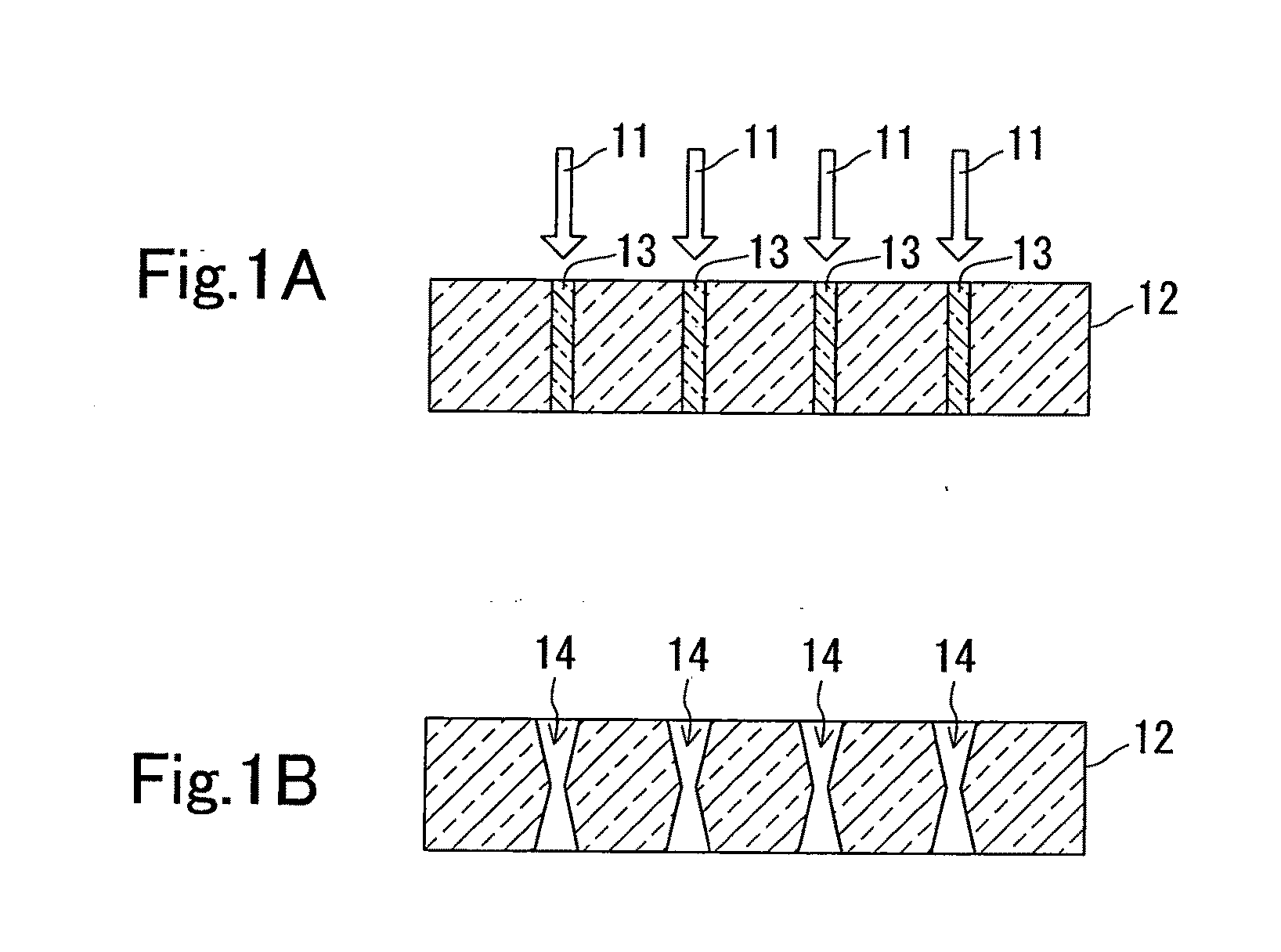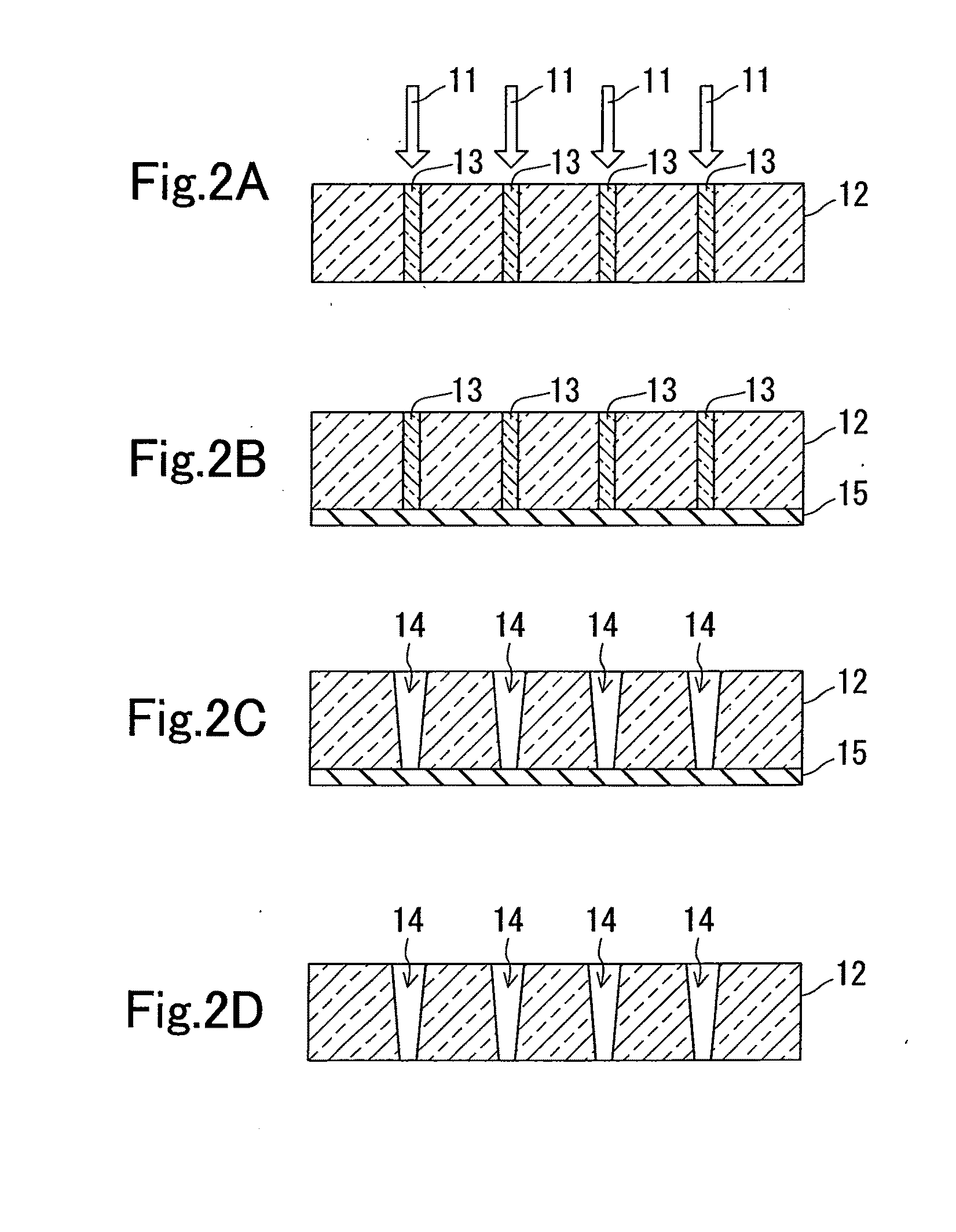Glass Processing Method Using Laser and Processing Device
a glass and laser technology, applied in the field of laser processing methods and processing devices, can solve the problems of inability to easily control the shape of the holes formed in the glass by laser irradiation with good reproducibility, and the fundamental wave cannot easily condense into a small spot, etc., to achieve the effect of reducing glass deformation, large numerical aperture, and easy variation of the size of the hol
- Summary
- Abstract
- Description
- Claims
- Application Information
AI Technical Summary
Benefits of technology
Problems solved by technology
Method used
Image
Examples
example 1
[0055]The following will describe an example of processing a glass plate made of titanium silicate glass (thickness: 0.3 mm; absorption coefficient at 355 nm: 8 cm−1). The percentages of the glass components are shown in Table 2.
TABLE 2ExamplesComparative1, 3, 524example 1Glass typeTitaniumTitaniumSilicateSoda-limePYREXsilicateComponentsSiO237.572.082.749.6(mol %)B2O312.5—11.6—TiO225.0——14.9Al2O3—0.91.419.8Na2O25.012.73.5—K2O——0.8—MgO—6.0—14.9CaO—8.4——CeO2———0.8Total100100100100
[0056]As the laser, a high repetition pulsed laser (wavelength: 355 nm; repetition frequency: 10 kHz) emitted from a Nd:YAG laser device (210S-UV, LightWave) was used. The laser pulse emitted from the laser device (pulse width: 9 ns; power: 370 mW; beam diameter: 1 mm) was expanded thirty-six times with a beam expander, narrowed by an aperture 14 mm in diameter, and condensed inside the glass plate with an fθ lens having a focal length of 160 mm. The diameter of the beam incident on the lens was 14 mm. The la...
example 2
[0063]The following will describe an example of processing a glass plate made of soda-lime glass (thickness: 0.41 mm; absorption coefficient at 355 nm: 0.3 cm−1). The percentages of the glass components are shown in Table 2.
[0064]As the laser, a high repetition pulsed laser (wavelength: 355 nm; repetition frequency: 20 kHz) emitted from a Nd:YAG laser device (Photonics Industries) was used. The laser pulse emitted from the laser device (pulse width: 24 ns; power: 450 mW; beam diameter: 1 mm) was expanded six times with a beam expander, and condensed inside the glass plate with an fθ lens having a focal length of 100 mm. The diameter of the beam incident on the lens was 6 mm. The laser beam was condensed at a position away from the top surface of the glass plate by a physical length of 0.20 mm. The laser beam was scanned at 1000 mm / s to prevent overlap of the irradiation pulses.
[0065]By the irradiation with the laser beam, recessed portions having a diameter of about 2 μm were formed...
example 3
[0068]The following will describe an example of processing a glass plate made of titanium silicate glass (thickness: 0.3 mm; absorption coefficient at 355 nm: 8 cm−1). The fractions of the glass components are shown in Table 2.
[0069]As the laser, a high repetition pulsed laser (wavelength: 355 nm; repetition frequency: 20 kHz) emitted from a Nd:YAG laser device (Photonics Industries) was used. The laser pulse emitted from the laser device (pulse width: 24 ns; power: 800 mW; beam diameter: 1 mm) was expanded six times with a beam expander, and condensed inside the glass plate with an fθ lens having a focal length of 100 mm. The diameter of the beam incident on the lens was 6 mm. The laser beam was condensed at a position away from the top surface of the glass plate by a physical length of 0.15 mm. The laser beam was scanned at 1000 mm / s to prevent overlap of the irradiation pulses.
[0070]By the irradiation with the laser beam, recessed portions having a diameter of about 9 μm and a de...
PUM
| Property | Measurement | Unit |
|---|---|---|
| Time | aaaaa | aaaaa |
| Time | aaaaa | aaaaa |
| Distance | aaaaa | aaaaa |
Abstract
Description
Claims
Application Information
 Login to View More
Login to View More - R&D
- Intellectual Property
- Life Sciences
- Materials
- Tech Scout
- Unparalleled Data Quality
- Higher Quality Content
- 60% Fewer Hallucinations
Browse by: Latest US Patents, China's latest patents, Technical Efficacy Thesaurus, Application Domain, Technology Topic, Popular Technical Reports.
© 2025 PatSnap. All rights reserved.Legal|Privacy policy|Modern Slavery Act Transparency Statement|Sitemap|About US| Contact US: help@patsnap.com



